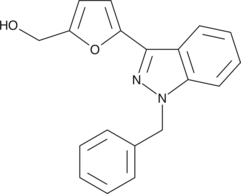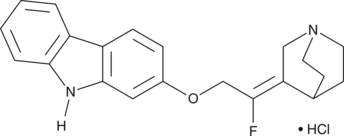Chemicals
Showing 40351–40500 of 41137 results
-
IL-15 is a pro-inflammatory cytokine with roles in cancer and autoimmune diseases, including rheumatoid arthritis, inflammatory bowel disease, psoriasis, celiac disease, and alopecia areata.{28368} IL-15 can induce IL-17 production by CD4 T cells.{28367} Y320 is an inhibitor of the release of IL-17 by CD4 T cells stimulated with IL-15, either alone or in combination with CXCL12 and anti-CD3 monoclonal antibody (IC50s = 57.4 and 25.7 nM, respectively).{28367} Oral administration of Y320 (0.3-3 mg/kg) reduces the expression of inflammatory cytokines, including IL-17, and inhibits joint destruction in type II collagen-induced arthritis (CIA) in mice.{28367} In this model, it acts synergistically with TNF-α monoclonal antibody in ameliorating arthritis and joint destruction scores.{28367} Y320 also significantly reduces joint swelling in cynomolgus monkey CIA.{28367}
Brand:CaymanSKU:-Out of stock
IL-15 is a pro-inflammatory cytokine with roles in cancer and autoimmune diseases, including rheumatoid arthritis, inflammatory bowel disease, psoriasis, celiac disease, and alopecia areata.{28368} IL-15 can induce IL-17 production by CD4 T cells.{28367} Y320 is an inhibitor of the release of IL-17 by CD4 T cells stimulated with IL-15, either alone or in combination with CXCL12 and anti-CD3 monoclonal antibody (IC50s = 57.4 and 25.7 nM, respectively).{28367} Oral administration of Y320 (0.3-3 mg/kg) reduces the expression of inflammatory cytokines, including IL-17, and inhibits joint destruction in type II collagen-induced arthritis (CIA) in mice.{28367} In this model, it acts synergistically with TNF-α monoclonal antibody in ameliorating arthritis and joint destruction scores.{28367} Y320 also significantly reduces joint swelling in cynomolgus monkey CIA.{28367}
Brand:CaymanSKU:-Out of stock
IL-15 is a pro-inflammatory cytokine with roles in cancer and autoimmune diseases, including rheumatoid arthritis, inflammatory bowel disease, psoriasis, celiac disease, and alopecia areata.{28368} IL-15 can induce IL-17 production by CD4 T cells.{28367} Y320 is an inhibitor of the release of IL-17 by CD4 T cells stimulated with IL-15, either alone or in combination with CXCL12 and anti-CD3 monoclonal antibody (IC50s = 57.4 and 25.7 nM, respectively).{28367} Oral administration of Y320 (0.3-3 mg/kg) reduces the expression of inflammatory cytokines, including IL-17, and inhibits joint destruction in type II collagen-induced arthritis (CIA) in mice.{28367} In this model, it acts synergistically with TNF-α monoclonal antibody in ameliorating arthritis and joint destruction scores.{28367} Y320 also significantly reduces joint swelling in cynomolgus monkey CIA.{28367}
Brand:CaymanSKU:-Out of stock
Yangonin is a natural kavalactone from the kava plant, P. methysticum. It enhances the binding of bicuculline at the γ-amino butyric acid (GABA) receptor GABAA at 1.0 µM.{25728} Yangonin also binds the central cannabinoid (CB1) receptor with a Ki value of 0.72 µM, but whether it serves as an agonist or antagonist at this receptor remains to be determined.{25724} Yangonin blocks the activation of NF-κB by TNF-α.{25725} It also inhibits anchorage-dependent and independent growth of bladder cancer cell lines through induction of autophagic cell death (IC50s = 15-59 mg/mL).{36099}
Brand:CaymanSKU:-Yangonin is a natural kavalactone from the kava plant, P. methysticum. It enhances the binding of bicuculline at the γ-amino butyric acid (GABA) receptor GABAA at 1.0 µM.{25728} Yangonin also binds the central cannabinoid (CB1) receptor with a Ki value of 0.72 µM, but whether it serves as an agonist or antagonist at this receptor remains to be determined.{25724} Yangonin blocks the activation of NF-κB by TNF-α.{25725} It also inhibits anchorage-dependent and independent growth of bladder cancer cell lines through induction of autophagic cell death (IC50s = 15-59 mg/mL).{36099}
Brand:CaymanSKU:-Yangonin is a natural kavalactone from the kava plant, P. methysticum. It enhances the binding of bicuculline at the γ-amino butyric acid (GABA) receptor GABAA at 1.0 µM.{25728} Yangonin also binds the central cannabinoid (CB1) receptor with a Ki value of 0.72 µM, but whether it serves as an agonist or antagonist at this receptor remains to be determined.{25724} Yangonin blocks the activation of NF-κB by TNF-α.{25725} It also inhibits anchorage-dependent and independent growth of bladder cancer cell lines through induction of autophagic cell death (IC50s = 15-59 mg/mL).{36099}
Brand:CaymanSKU:-Yangonin is a natural kavalactone from the kava plant, P. methysticum. It enhances the binding of bicuculline at the γ-amino butyric acid (GABA) receptor GABAA at 1.0 µM.{25728} Yangonin also binds the central cannabinoid (CB1) receptor with a Ki value of 0.72 µM, but whether it serves as an agonist or antagonist at this receptor remains to be determined.{25724} Yangonin blocks the activation of NF-κB by TNF-α.{25725} It also inhibits anchorage-dependent and independent growth of bladder cancer cell lines through induction of autophagic cell death (IC50s = 15-59 mg/mL).{36099}
Brand:CaymanSKU:-Yatein is a lignan that has been found in C. formosana and has diverse biological activities.{46751,46752,46753,46754} It inhibits the cytochrome P450 (CYP) isoform CYP3A4 (IC50 = 1 μM).{46751} Yatein inhibits herpes simplex virus 1 (HSV-1) replication in a plaque reduction assay (IC50 = 30.6 μM).{46752} It induces apoptosis and production of reactive oxygen species (ROS) in, and is cytotoxic to, A549 and CL1-5 non-small cell lung cancer (NSCLC) cells (IC50s = 3.5 and 1.9 μM, respectively).{46753} Yatein inhibits aggregation of rabbit platelets induced by platelet-activating factor (PAF), collagen, or arachidonic acid (Item Nos. 90010 | 90010.1 | 10006607) in a concentration-dependent manner.{46754}
Brand:CaymanSKU:29766 - 1 mgAvailable on backorder
Yatein is a lignan that has been found in C. formosana and has diverse biological activities.{46751,46752,46753,46754} It inhibits the cytochrome P450 (CYP) isoform CYP3A4 (IC50 = 1 μM).{46751} Yatein inhibits herpes simplex virus 1 (HSV-1) replication in a plaque reduction assay (IC50 = 30.6 μM).{46752} It induces apoptosis and production of reactive oxygen species (ROS) in, and is cytotoxic to, A549 and CL1-5 non-small cell lung cancer (NSCLC) cells (IC50s = 3.5 and 1.9 μM, respectively).{46753} Yatein inhibits aggregation of rabbit platelets induced by platelet-activating factor (PAF), collagen, or arachidonic acid (Item Nos. 90010 | 90010.1 | 10006607) in a concentration-dependent manner.{46754}
Brand:CaymanSKU:29766 - 500 µgAvailable on backorder
YC-1 is an nitric oxide (NO)-independent activator of soluble guanylyl cyclase. It inhibits collagen (10 µg/ml) and thrombin (0.1 U/ml) induced platelet aggregation with IC50 values of 11.7-14.6 and 57.3-59.3 µM, respectively.{4218,4219} In the absence of NO or carbon monoxide (CO), 200 µM YC-1 increases the activity of purified soluble guanylyl cyclase 12-fold, with an ED50 value of 20 µM.{4220} At a concentration of 200 µM, YC-1 potentiates the maximal activity of soluble guanylyl cyclase in the presence of NO or CO by 40% and >3,000%, respectively.
Brand:CaymanSKU:81560 - 1 mgAvailable on backorder
YC-1 is an nitric oxide (NO)-independent activator of soluble guanylyl cyclase. It inhibits collagen (10 µg/ml) and thrombin (0.1 U/ml) induced platelet aggregation with IC50 values of 11.7-14.6 and 57.3-59.3 µM, respectively.{4218,4219} In the absence of NO or carbon monoxide (CO), 200 µM YC-1 increases the activity of purified soluble guanylyl cyclase 12-fold, with an ED50 value of 20 µM.{4220} At a concentration of 200 µM, YC-1 potentiates the maximal activity of soluble guanylyl cyclase in the presence of NO or CO by 40% and >3,000%, respectively.
Brand:CaymanSKU:81560 - 10 mgAvailable on backorder
YC-1 is an nitric oxide (NO)-independent activator of soluble guanylyl cyclase. It inhibits collagen (10 µg/ml) and thrombin (0.1 U/ml) induced platelet aggregation with IC50 values of 11.7-14.6 and 57.3-59.3 µM, respectively.{4218,4219} In the absence of NO or carbon monoxide (CO), 200 µM YC-1 increases the activity of purified soluble guanylyl cyclase 12-fold, with an ED50 value of 20 µM.{4220} At a concentration of 200 µM, YC-1 potentiates the maximal activity of soluble guanylyl cyclase in the presence of NO or CO by 40% and >3,000%, respectively.
Brand:CaymanSKU:81560 - 5 mgAvailable on backorder
YC-1 is an nitric oxide (NO)-independent activator of soluble guanylyl cyclase. It inhibits collagen (10 µg/ml) and thrombin (0.1 U/ml) induced platelet aggregation with IC50 values of 11.7-14.6 and 57.3-59.3 µM, respectively.{4218,4219} In the absence of NO or carbon monoxide (CO), 200 µM YC-1 increases the activity of purified soluble guanylyl cyclase 12-fold, with an ED50 value of 20 µM.{4220} At a concentration of 200 µM, YC-1 potentiates the maximal activity of soluble guanylyl cyclase in the presence of NO or CO by 40% and >3,000%, respectively.
Brand:CaymanSKU:81560 - 50 mgAvailable on backorder
YE 120 is an agonist of G protein-coupled receptor 35 (GPR35) with an EC50 value of 32 nM in a dynamic mass redistribution (DMR) assay using HT-29 cells.{49435} It induces β-arrestin translocation in Tango GPR35-bla U2OS cells (EC50 = 10.2 µM). YE 120 (10 µM) promotes wound closure in YAMC colonic epithelial and IEC-6 intestinal epithelial cell monolayers, an effect that can be blocked by the GPR35 antagonist CID-2745687 (Item No. 12046).{49436}
Brand:CaymanSKU:29720 - 1 mgAvailable on backorder
YE 120 is an agonist of G protein-coupled receptor 35 (GPR35) with an EC50 value of 32 nM in a dynamic mass redistribution (DMR) assay using HT-29 cells.{49435} It induces β-arrestin translocation in Tango GPR35-bla U2OS cells (EC50 = 10.2 µM). YE 120 (10 µM) promotes wound closure in YAMC colonic epithelial and IEC-6 intestinal epithelial cell monolayers, an effect that can be blocked by the GPR35 antagonist CID-2745687 (Item No. 12046).{49436}
Brand:CaymanSKU:29720 - 5 mgAvailable on backorder
YF-2 is a histone acetyltransferase (HAT) activator.{53930} It inhibits proliferation of CCRF-CEM, Hs 578T, A549, and U251 cancer cells (IC50s = 88.7-286 µM), as well as multidrug-resistant NCI/ADR-RES cells (IC50 = 44.8 µM). YF-2 (5 mg/kg) increases reduced acetylated histone H3 levels in a mouse of model of Alzheimer’s disease induced by amyloid-β (1-42) (Aβ42; Item No. 20574). YF-2 (20 mg/kg) reduces contextual fear memory deficits in the transgenic APP/PS1 mouse model of Alzheimer’s disease.
Brand:CaymanSKU:31230 - 1 mgAvailable on backorder
YF-2 is a histone acetyltransferase (HAT) activator.{53930} It inhibits proliferation of CCRF-CEM, Hs 578T, A549, and U251 cancer cells (IC50s = 88.7-286 µM), as well as multidrug-resistant NCI/ADR-RES cells (IC50 = 44.8 µM). YF-2 (5 mg/kg) increases reduced acetylated histone H3 levels in a mouse of model of Alzheimer’s disease induced by amyloid-β (1-42) (Aβ42; Item No. 20574). YF-2 (20 mg/kg) reduces contextual fear memory deficits in the transgenic APP/PS1 mouse model of Alzheimer’s disease.
Brand:CaymanSKU:31230 - 10 mgAvailable on backorder
YF-2 is a histone acetyltransferase (HAT) activator.{53930} It inhibits proliferation of CCRF-CEM, Hs 578T, A549, and U251 cancer cells (IC50s = 88.7-286 µM), as well as multidrug-resistant NCI/ADR-RES cells (IC50 = 44.8 µM). YF-2 (5 mg/kg) increases reduced acetylated histone H3 levels in a mouse of model of Alzheimer’s disease induced by amyloid-β (1-42) (Aβ42; Item No. 20574). YF-2 (20 mg/kg) reduces contextual fear memory deficits in the transgenic APP/PS1 mouse model of Alzheimer’s disease.
Brand:CaymanSKU:31230 - 25 mgAvailable on backorder
YF-2 is a histone acetyltransferase (HAT) activator.{53930} It inhibits proliferation of CCRF-CEM, Hs 578T, A549, and U251 cancer cells (IC50s = 88.7-286 µM), as well as multidrug-resistant NCI/ADR-RES cells (IC50 = 44.8 µM). YF-2 (5 mg/kg) increases reduced acetylated histone H3 levels in a mouse of model of Alzheimer’s disease induced by amyloid-β (1-42) (Aβ42; Item No. 20574). YF-2 (20 mg/kg) reduces contextual fear memory deficits in the transgenic APP/PS1 mouse model of Alzheimer’s disease.
Brand:CaymanSKU:31230 - 5 mgAvailable on backorder
YH 239-EE is an ethyl ester prodrug form of YH 239, a potent inhibitor of the p53-MDM2 protein-protein interaction.{52286} YH 239-EE (20 μM) inhibits the growth of OCI-AML-3 cells and halts the cell cycle at the sub-G1 phase and induces apoptosis in NB4 and MOLM-13 cells.
Brand:CaymanSKU:27678 - 10 mgAvailable on backorder
YH 239-EE is an ethyl ester prodrug form of YH 239, a potent inhibitor of the p53-MDM2 protein-protein interaction.{52286} YH 239-EE (20 μM) inhibits the growth of OCI-AML-3 cells and halts the cell cycle at the sub-G1 phase and induces apoptosis in NB4 and MOLM-13 cells.
Brand:CaymanSKU:27678 - 25 mgAvailable on backorder
YH 239-EE is an ethyl ester prodrug form of YH 239, a potent inhibitor of the p53-MDM2 protein-protein interaction.{52286} YH 239-EE (20 μM) inhibits the growth of OCI-AML-3 cells and halts the cell cycle at the sub-G1 phase and induces apoptosis in NB4 and MOLM-13 cells.
Brand:CaymanSKU:27678 - 5 mgAvailable on backorder
YH 239-EE is an ethyl ester prodrug form of YH 239, a potent inhibitor of the p53-MDM2 protein-protein interaction.{52286} YH 239-EE (20 μM) inhibits the growth of OCI-AML-3 cells and halts the cell cycle at the sub-G1 phase and induces apoptosis in NB4 and MOLM-13 cells.
Brand:CaymanSKU:27678 - 50 mgAvailable on backorder
YK-11 is an androgen receptor partial agonist that activates androgen receptor transcriptional activity in HEK293 cells overexpressing androgen receptors when used at a concentration of 0.1 μM.{48154} It induces expression of the androgen receptor target genes FKBP51 and FGF18 in HEK293 cells when used at a concentration of 10 μM. YK-11 accelerates nuclear translocation of androgen receptors without inducing interaction between the androgen receptor N- and C-termini. In C2C12 cells, YK-11 (500 nM) increases expression of the myogenic regulatory factors MyoD, Myf5, and myogenin, as well as follistatin (Fst), and induces myogenic differentiation.{48155} YK-11 also accelerates proliferation and mineralization and increases expression of the osteoblast differentiation markers osteoprotegerin and osteocalcin in MC3T3-E1 mouse osteoblast cells.{48156}
Brand:CaymanSKU:9003137 - 10 mgAvailable on backorder
YK-11 is an androgen receptor partial agonist that activates androgen receptor transcriptional activity in HEK293 cells overexpressing androgen receptors when used at a concentration of 0.1 μM.{48154} It induces expression of the androgen receptor target genes FKBP51 and FGF18 in HEK293 cells when used at a concentration of 10 μM. YK-11 accelerates nuclear translocation of androgen receptors without inducing interaction between the androgen receptor N- and C-termini. In C2C12 cells, YK-11 (500 nM) increases expression of the myogenic regulatory factors MyoD, Myf5, and myogenin, as well as follistatin (Fst), and induces myogenic differentiation.{48155} YK-11 also accelerates proliferation and mineralization and increases expression of the osteoblast differentiation markers osteoprotegerin and osteocalcin in MC3T3-E1 mouse osteoblast cells.{48156}
Brand:CaymanSKU:9003137 - 100 mgAvailable on backorder
YK-11 is an androgen receptor partial agonist that activates androgen receptor transcriptional activity in HEK293 cells overexpressing androgen receptors when used at a concentration of 0.1 μM.{48154} It induces expression of the androgen receptor target genes FKBP51 and FGF18 in HEK293 cells when used at a concentration of 10 μM. YK-11 accelerates nuclear translocation of androgen receptors without inducing interaction between the androgen receptor N- and C-termini. In C2C12 cells, YK-11 (500 nM) increases expression of the myogenic regulatory factors MyoD, Myf5, and myogenin, as well as follistatin (Fst), and induces myogenic differentiation.{48155} YK-11 also accelerates proliferation and mineralization and increases expression of the osteoblast differentiation markers osteoprotegerin and osteocalcin in MC3T3-E1 mouse osteoblast cells.{48156}
Brand:CaymanSKU:9003137 - 50 mgAvailable on backorder
YK-3-237 is a chalcone derivative and an activator of sirtuin 1 (SIRT1).{36848,36849} It inhibits colchicine binding to tubulin in a concentration-dependent manner and tubulin polymerization (IC50 = 31 μM) and induces microtubule loss in A-10 cells (EC50 = 16.5 μM).{36848} YK-3-237 inhibits cell growth in a panel of leukemia, non-small cell lung, colon, CNS, melanoma, ovarian, renal, prostate, and breast cancer cell lines (GI50s = 50s = 0.160-5.031 μM).
Brand:CaymanSKU:21516 -Out of stock
YK-3-237 is a chalcone derivative and an activator of sirtuin 1 (SIRT1).{36848,36849} It inhibits colchicine binding to tubulin in a concentration-dependent manner and tubulin polymerization (IC50 = 31 μM) and induces microtubule loss in A-10 cells (EC50 = 16.5 μM).{36848} YK-3-237 inhibits cell growth in a panel of leukemia, non-small cell lung, colon, CNS, melanoma, ovarian, renal, prostate, and breast cancer cell lines (GI50s = 50s = 0.160-5.031 μM).
Brand:CaymanSKU:21516 -Out of stock
YK-3-237 is a chalcone derivative and an activator of sirtuin 1 (SIRT1).{36848,36849} It inhibits colchicine binding to tubulin in a concentration-dependent manner and tubulin polymerization (IC50 = 31 μM) and induces microtubule loss in A-10 cells (EC50 = 16.5 μM).{36848} YK-3-237 inhibits cell growth in a panel of leukemia, non-small cell lung, colon, CNS, melanoma, ovarian, renal, prostate, and breast cancer cell lines (GI50s = 50s = 0.160-5.031 μM).
Brand:CaymanSKU:21516 -Out of stock
YK-3-237 is a chalcone derivative and an activator of sirtuin 1 (SIRT1).{36848,36849} It inhibits colchicine binding to tubulin in a concentration-dependent manner and tubulin polymerization (IC50 = 31 μM) and induces microtubule loss in A-10 cells (EC50 = 16.5 μM).{36848} YK-3-237 inhibits cell growth in a panel of leukemia, non-small cell lung, colon, CNS, melanoma, ovarian, renal, prostate, and breast cancer cell lines (GI50s = 50s = 0.160-5.031 μM).
Brand:CaymanSKU:21516 -Out of stock
YL-109 is an anticancer agent.{52496} It inhibits the proliferation of MCF-7 and MDA-MB-231 cells (IC50s = 0.0858 and 4.2 µM, respectively), as well as migration and invasion by MDA-MB-231 cells in vitro. It induces expression of carboxyl terminus of Hsp70-interacting protein (CHIP) in MDA-MB-231 cells in an AHR-dependent manner. YL-109 (1 µM) inhibits MDA-MB-231-derived cancer stem cell (CSC) mammosphere formation. In vivo, YL-109 (15 mg/kg) reduces tumor volume and the number of metastases in an MDA-MB-231 mouse xenograft model.
Brand:CaymanSKU:30290 - 10 mgAvailable on backorder
YL-109 is an anticancer agent.{52496} It inhibits the proliferation of MCF-7 and MDA-MB-231 cells (IC50s = 0.0858 and 4.2 µM, respectively), as well as migration and invasion by MDA-MB-231 cells in vitro. It induces expression of carboxyl terminus of Hsp70-interacting protein (CHIP) in MDA-MB-231 cells in an AHR-dependent manner. YL-109 (1 µM) inhibits MDA-MB-231-derived cancer stem cell (CSC) mammosphere formation. In vivo, YL-109 (15 mg/kg) reduces tumor volume and the number of metastases in an MDA-MB-231 mouse xenograft model.
Brand:CaymanSKU:30290 - 25 mgAvailable on backorder
YL-109 is an anticancer agent.{52496} It inhibits the proliferation of MCF-7 and MDA-MB-231 cells (IC50s = 0.0858 and 4.2 µM, respectively), as well as migration and invasion by MDA-MB-231 cells in vitro. It induces expression of carboxyl terminus of Hsp70-interacting protein (CHIP) in MDA-MB-231 cells in an AHR-dependent manner. YL-109 (1 µM) inhibits MDA-MB-231-derived cancer stem cell (CSC) mammosphere formation. In vivo, YL-109 (15 mg/kg) reduces tumor volume and the number of metastases in an MDA-MB-231 mouse xenograft model.
Brand:CaymanSKU:30290 - 5 mgAvailable on backorder
YL-109 is an anticancer agent.{52496} It inhibits the proliferation of MCF-7 and MDA-MB-231 cells (IC50s = 0.0858 and 4.2 µM, respectively), as well as migration and invasion by MDA-MB-231 cells in vitro. It induces expression of carboxyl terminus of Hsp70-interacting protein (CHIP) in MDA-MB-231 cells in an AHR-dependent manner. YL-109 (1 µM) inhibits MDA-MB-231-derived cancer stem cell (CSC) mammosphere formation. In vivo, YL-109 (15 mg/kg) reduces tumor volume and the number of metastases in an MDA-MB-231 mouse xenograft model.
Brand:CaymanSKU:30290 - 50 mgAvailable on backorder
YLF-466D is an orally bioavailable activator of AMP-activated protein kinase (AMPK), an enzyme involved in regulation of cellular energy homeostasis.{40039} YLF-466D activates AMPK at a concentration of 150 µM in platelets. It inhibits platelet aggregation induced by thrombin, ADP, and collagen (IC50s = 84, 55, and 87 µM, respectively) and inhibits aggregation of whole blood. YLF-466D leads to dose-dependent glucose uptake in L6 myotubes and, at a dose of 150 mg/kg, improves glucose tolerance in two mouse models of diabetes.{40040,40038}
Brand:CaymanSKU:-Available on backorder
YLF-466D is an orally bioavailable activator of AMP-activated protein kinase (AMPK), an enzyme involved in regulation of cellular energy homeostasis.{40039} YLF-466D activates AMPK at a concentration of 150 µM in platelets. It inhibits platelet aggregation induced by thrombin, ADP, and collagen (IC50s = 84, 55, and 87 µM, respectively) and inhibits aggregation of whole blood. YLF-466D leads to dose-dependent glucose uptake in L6 myotubes and, at a dose of 150 mg/kg, improves glucose tolerance in two mouse models of diabetes.{40040,40038}
Brand:CaymanSKU:-Available on backorder
YLF-466D is an orally bioavailable activator of AMP-activated protein kinase (AMPK), an enzyme involved in regulation of cellular energy homeostasis.{40039} YLF-466D activates AMPK at a concentration of 150 µM in platelets. It inhibits platelet aggregation induced by thrombin, ADP, and collagen (IC50s = 84, 55, and 87 µM, respectively) and inhibits aggregation of whole blood. YLF-466D leads to dose-dependent glucose uptake in L6 myotubes and, at a dose of 150 mg/kg, improves glucose tolerance in two mouse models of diabetes.{40040,40038}
Brand:CaymanSKU:-Available on backorder
Survivin, a member of the inhibitor of apoptosis (IAP) family, plays an important role in drug resistance and cancer cell survival in many types of cancer. YM-155 is a novel small molecule that suppresses transactivation of survivin through direct binding to its promoter.{22213} It selectively suppresses expression of survivin and induces apoptosis in p53-deficient cancer cells in vitro at 10 nM.{22212} At concentrations up to 100 nM, YM-155 has little effect on expression levels of other IAP- or Bcl-2-related proteins.{22212} YM-155 exerts anti-tumor effects in various in vivo cancer models, including prostate, pancreatic, and lung cancer.{22212,22211}
Brand:CaymanSKU:11490 - 1 mgAvailable on backorder
Survivin, a member of the inhibitor of apoptosis (IAP) family, plays an important role in drug resistance and cancer cell survival in many types of cancer. YM-155 is a novel small molecule that suppresses transactivation of survivin through direct binding to its promoter.{22213} It selectively suppresses expression of survivin and induces apoptosis in p53-deficient cancer cells in vitro at 10 nM.{22212} At concentrations up to 100 nM, YM-155 has little effect on expression levels of other IAP- or Bcl-2-related proteins.{22212} YM-155 exerts anti-tumor effects in various in vivo cancer models, including prostate, pancreatic, and lung cancer.{22212,22211}
Brand:CaymanSKU:11490 - 10 mgAvailable on backorder
Survivin, a member of the inhibitor of apoptosis (IAP) family, plays an important role in drug resistance and cancer cell survival in many types of cancer. YM-155 is a novel small molecule that suppresses transactivation of survivin through direct binding to its promoter.{22213} It selectively suppresses expression of survivin and induces apoptosis in p53-deficient cancer cells in vitro at 10 nM.{22212} At concentrations up to 100 nM, YM-155 has little effect on expression levels of other IAP- or Bcl-2-related proteins.{22212} YM-155 exerts anti-tumor effects in various in vivo cancer models, including prostate, pancreatic, and lung cancer.{22212,22211}
Brand:CaymanSKU:11490 - 25 mgAvailable on backorder
Survivin, a member of the inhibitor of apoptosis (IAP) family, plays an important role in drug resistance and cancer cell survival in many types of cancer. YM-155 is a novel small molecule that suppresses transactivation of survivin through direct binding to its promoter.{22213} It selectively suppresses expression of survivin and induces apoptosis in p53-deficient cancer cells in vitro at 10 nM.{22212} At concentrations up to 100 nM, YM-155 has little effect on expression levels of other IAP- or Bcl-2-related proteins.{22212} YM-155 exerts anti-tumor effects in various in vivo cancer models, including prostate, pancreatic, and lung cancer.{22212,22211}
Brand:CaymanSKU:11490 - 5 mgAvailable on backorder
PIKfyve is a phosphoinositide kinase (PIK) that contains a FYVE-type zinc finger domain, which binds phosphatidylinositol 3-phosphate (PI3P). PIKfyve phosphorylates PI3P to produce PI-(3,5)-P2, which is involved in cellular processes including membrane trafficking and cytoskeletal reorganization. YM-201636 is a cell-permeable and selective inhibitor of PIKfyve (IC50 = 33 nM).{18015} It reversibly impairs endosomal trafficking in NIH3T3 cells, mimicking the effect produced by depleting PIKfyve with siRNA.{18015} YM-201636 also blocks retroviral exit by budding from cells, apparently by interfering with the endosomal sorting complex required for transport (ESCRT) machinery.{18015} In adipocytes, YM-201636 also inhibits basal and insulin-activated 2-deoxyglucose uptake (IC50 = 54 nM).{18016}
Brand:CaymanSKU:-PIKfyve is a phosphoinositide kinase (PIK) that contains a FYVE-type zinc finger domain, which binds phosphatidylinositol 3-phosphate (PI3P). PIKfyve phosphorylates PI3P to produce PI-(3,5)-P2, which is involved in cellular processes including membrane trafficking and cytoskeletal reorganization. YM-201636 is a cell-permeable and selective inhibitor of PIKfyve (IC50 = 33 nM).{18015} It reversibly impairs endosomal trafficking in NIH3T3 cells, mimicking the effect produced by depleting PIKfyve with siRNA.{18015} YM-201636 also blocks retroviral exit by budding from cells, apparently by interfering with the endosomal sorting complex required for transport (ESCRT) machinery.{18015} In adipocytes, YM-201636 also inhibits basal and insulin-activated 2-deoxyglucose uptake (IC50 = 54 nM).{18016}
Brand:CaymanSKU:-PIKfyve is a phosphoinositide kinase (PIK) that contains a FYVE-type zinc finger domain, which binds phosphatidylinositol 3-phosphate (PI3P). PIKfyve phosphorylates PI3P to produce PI-(3,5)-P2, which is involved in cellular processes including membrane trafficking and cytoskeletal reorganization. YM-201636 is a cell-permeable and selective inhibitor of PIKfyve (IC50 = 33 nM).{18015} It reversibly impairs endosomal trafficking in NIH3T3 cells, mimicking the effect produced by depleting PIKfyve with siRNA.{18015} YM-201636 also blocks retroviral exit by budding from cells, apparently by interfering with the endosomal sorting complex required for transport (ESCRT) machinery.{18015} In adipocytes, YM-201636 also inhibits basal and insulin-activated 2-deoxyglucose uptake (IC50 = 54 nM).{18016}
Brand:CaymanSKU:-YM-254890 is cyclic depsipeptide originally isolated from Chromobacterium and an inhibitor of Gαq/11.{52332} It inhibits Gαq/11-mediated intracellular calcium mobilization induced by 2MeSADP or methacholine in C6-15 cells expressing the purinergic P2Y1 receptor (IC50 = 0.15 µM) and in CHO cells expressing M1 muscarinic acetylcholine receptors (IC50 = 0.15 µM), respectively, but has no effect on Gαi-mediated calcium mobilization induced by fMLP in HL-60 cells (IC50 = >10 µM). YM-254890 inhibits platelet aggregation induced by ADP, collagen, thrombin receptor agonist peptide (TRAP), arachidonic acid (Item Nos. 90010 | 90010.1 | 10006607), or U-46619 (Item No. 16450) in isolated human platelet-rich plasma (IC50s = 0.39, 0.15, 0.71, 0.25, and 0.34 µM, respectively).{52333} It reduces shear stress-induced thrombus formation in isolated human whole blood. YM-254890 (1, 3, and 10 µg/kg) reduces platelet thrombus formation in a cynomolgus monkey model of femoral artery thrombosis.
Brand:CaymanSKU:29735 - 1 mgAvailable on backorder
Secreted phospholipases A2 (sPLA2s) are a diverse family of low molecular weight PLA2s with tissue-specific expression patterns and actions.{23479} The group IIA sPLA2 (sPLA2-IIA) was originally purified from platelets and exudates from patients with rheumatoid arthritis.{23479} Its expression can be induced by inflammatory mediators, and mouse studies suggest that it may play roles in colorectal polyposis, atherosclerosis, and bacterial infections.{23479,23478} YM-26734 is a derivative of a compound isolated from the fruit of H. amygdaline that competitively inhibits rabbit platelet sPLA2 with an IC50 value of 85 nM.{28705} It inhibits sPLA2-hGIIA, -mGIIA, -rGIIA, -hGV, -mGV, -hGX, and -mGX with IC50 values of 80, 30, 120, 110, 520, >1600, and >1600 nM, respectively.{28706,28707} YM-26734 displays minimal activity at cytosolic PLA2, COX and lipoxygenase.{28705} At 45 µg/ear or 11 mg/kg i.v., YM-26734 has been used to ameliorate local inflammatory responses in TPA-induced mouse ear edema.{28705}
Brand:CaymanSKU:-Available on backorder
Secreted phospholipases A2 (sPLA2s) are a diverse family of low molecular weight PLA2s with tissue-specific expression patterns and actions.{23479} The group IIA sPLA2 (sPLA2-IIA) was originally purified from platelets and exudates from patients with rheumatoid arthritis.{23479} Its expression can be induced by inflammatory mediators, and mouse studies suggest that it may play roles in colorectal polyposis, atherosclerosis, and bacterial infections.{23479,23478} YM-26734 is a derivative of a compound isolated from the fruit of H. amygdaline that competitively inhibits rabbit platelet sPLA2 with an IC50 value of 85 nM.{28705} It inhibits sPLA2-hGIIA, -mGIIA, -rGIIA, -hGV, -mGV, -hGX, and -mGX with IC50 values of 80, 30, 120, 110, 520, >1600, and >1600 nM, respectively.{28706,28707} YM-26734 displays minimal activity at cytosolic PLA2, COX and lipoxygenase.{28705} At 45 µg/ear or 11 mg/kg i.v., YM-26734 has been used to ameliorate local inflammatory responses in TPA-induced mouse ear edema.{28705}
Brand:CaymanSKU:-Available on backorder
Secreted phospholipases A2 (sPLA2s) are a diverse family of low molecular weight PLA2s with tissue-specific expression patterns and actions.{23479} The group IIA sPLA2 (sPLA2-IIA) was originally purified from platelets and exudates from patients with rheumatoid arthritis.{23479} Its expression can be induced by inflammatory mediators, and mouse studies suggest that it may play roles in colorectal polyposis, atherosclerosis, and bacterial infections.{23479,23478} YM-26734 is a derivative of a compound isolated from the fruit of H. amygdaline that competitively inhibits rabbit platelet sPLA2 with an IC50 value of 85 nM.{28705} It inhibits sPLA2-hGIIA, -mGIIA, -rGIIA, -hGV, -mGV, -hGX, and -mGX with IC50 values of 80, 30, 120, 110, 520, >1600, and >1600 nM, respectively.{28706,28707} YM-26734 displays minimal activity at cytosolic PLA2, COX and lipoxygenase.{28705} At 45 µg/ear or 11 mg/kg i.v., YM-26734 has been used to ameliorate local inflammatory responses in TPA-induced mouse ear edema.{28705}
Brand:CaymanSKU:-Available on backorder
Secreted phospholipases A2 (sPLA2s) are a diverse family of low molecular weight PLA2s with tissue-specific expression patterns and actions.{23479} The group IIA sPLA2 (sPLA2-IIA) was originally purified from platelets and exudates from patients with rheumatoid arthritis.{23479} Its expression can be induced by inflammatory mediators, and mouse studies suggest that it may play roles in colorectal polyposis, atherosclerosis, and bacterial infections.{23479,23478} YM-26734 is a derivative of a compound isolated from the fruit of H. amygdaline that competitively inhibits rabbit platelet sPLA2 with an IC50 value of 85 nM.{28705} It inhibits sPLA2-hGIIA, -mGIIA, -rGIIA, -hGV, -mGV, -hGX, and -mGX with IC50 values of 80, 30, 120, 110, 520, >1600, and >1600 nM, respectively.{28706,28707} YM-26734 displays minimal activity at cytosolic PLA2, COX and lipoxygenase.{28705} At 45 µg/ear or 11 mg/kg i.v., YM-26734 has been used to ameliorate local inflammatory responses in TPA-induced mouse ear edema.{28705}
Brand:CaymanSKU:-Available on backorder
YM-298198 is a non-competitive antagonist of the metabotropic glutamate receptor type I (mGluR1; Ki = 19 nM).{38955} It is selective for mGluR1 over mGluR2-7 (IC50s = 0.016 and >10 μM, respectively). YM-298198 binds to rat cerebellum membranes (Ki = 20 nM). In vivo, YM-298198 (10 and 30 mg/kg, p.o.) increases nociceptive response latency in a mouse model of hyperalgesia induced by streptozotocin (Item No. 13104) without affecting motor coordination in a rotarod test. YM-298198 also reduces reinstatement of drug-seeking behavior induced by cocaine priming in rats.{38956}
Brand:CaymanSKU:22925 - 1 mgAvailable on backorder
YM-298198 is a non-competitive antagonist of the metabotropic glutamate receptor type I (mGluR1; Ki = 19 nM).{38955} It is selective for mGluR1 over mGluR2-7 (IC50s = 0.016 and >10 μM, respectively). YM-298198 binds to rat cerebellum membranes (Ki = 20 nM). In vivo, YM-298198 (10 and 30 mg/kg, p.o.) increases nociceptive response latency in a mouse model of hyperalgesia induced by streptozotocin (Item No. 13104) without affecting motor coordination in a rotarod test. YM-298198 also reduces reinstatement of drug-seeking behavior induced by cocaine priming in rats.{38956}
Brand:CaymanSKU:22925 - 10 mgAvailable on backorder
YM-298198 is a non-competitive antagonist of the metabotropic glutamate receptor type I (mGluR1; Ki = 19 nM).{38955} It is selective for mGluR1 over mGluR2-7 (IC50s = 0.016 and >10 μM, respectively). YM-298198 binds to rat cerebellum membranes (Ki = 20 nM). In vivo, YM-298198 (10 and 30 mg/kg, p.o.) increases nociceptive response latency in a mouse model of hyperalgesia induced by streptozotocin (Item No. 13104) without affecting motor coordination in a rotarod test. YM-298198 also reduces reinstatement of drug-seeking behavior induced by cocaine priming in rats.{38956}
Brand:CaymanSKU:22925 - 25 mgAvailable on backorder
YM-298198 is a non-competitive antagonist of the metabotropic glutamate receptor type I (mGluR1; Ki = 19 nM).{38955} It is selective for mGluR1 over mGluR2-7 (IC50s = 0.016 and >10 μM, respectively). YM-298198 binds to rat cerebellum membranes (Ki = 20 nM). In vivo, YM-298198 (10 and 30 mg/kg, p.o.) increases nociceptive response latency in a mouse model of hyperalgesia induced by streptozotocin (Item No. 13104) without affecting motor coordination in a rotarod test. YM-298198 also reduces reinstatement of drug-seeking behavior induced by cocaine priming in rats.{38956}
Brand:CaymanSKU:22925 - 5 mgAvailable on backorder
YM-53601 is a squalene synthase inhibitor (IC50s = 79 and 90 nM in HepG2 cells and rat liver microsomes, respectively).{16636} It inhibits cholesterol biosynthesis in rats (ED50 = 32 mg/kg).{16636} YM-53601 dose-dependently reduces plasma triglyceride and non-HDL cholesterol levels in hamsters fed both normal and high-fat diets. It also reduces viral RNA, core and NS3 protein production, and secreted viral particles in Huh7.5.1-8 cells infected with the hepatitis C virus (HCV) strain JFH-1 without affecting cell viability at concentrations ranging from 0.5 to 1.5 μM.{36948} YM-53601 (1-10 μM) confers protection against cytotoxicity induced by the bacterial pore-forming toxin pneumolysin in HBE1 and normal human bronchial epithelial (NHBE) cells.{36949}
Brand:CaymanSKU:-Available on backorder
YM-53601 is a squalene synthase inhibitor (IC50s = 79 and 90 nM in HepG2 cells and rat liver microsomes, respectively).{16636} It inhibits cholesterol biosynthesis in rats (ED50 = 32 mg/kg).{16636} YM-53601 dose-dependently reduces plasma triglyceride and non-HDL cholesterol levels in hamsters fed both normal and high-fat diets. It also reduces viral RNA, core and NS3 protein production, and secreted viral particles in Huh7.5.1-8 cells infected with the hepatitis C virus (HCV) strain JFH-1 without affecting cell viability at concentrations ranging from 0.5 to 1.5 μM.{36948} YM-53601 (1-10 μM) confers protection against cytotoxicity induced by the bacterial pore-forming toxin pneumolysin in HBE1 and normal human bronchial epithelial (NHBE) cells.{36949}
Brand:CaymanSKU:-Available on backorder
YM-53601 is a squalene synthase inhibitor (IC50s = 79 and 90 nM in HepG2 cells and rat liver microsomes, respectively).{16636} It inhibits cholesterol biosynthesis in rats (ED50 = 32 mg/kg).{16636} YM-53601 dose-dependently reduces plasma triglyceride and non-HDL cholesterol levels in hamsters fed both normal and high-fat diets. It also reduces viral RNA, core and NS3 protein production, and secreted viral particles in Huh7.5.1-8 cells infected with the hepatitis C virus (HCV) strain JFH-1 without affecting cell viability at concentrations ranging from 0.5 to 1.5 μM.{36948} YM-53601 (1-10 μM) confers protection against cytotoxicity induced by the bacterial pore-forming toxin pneumolysin in HBE1 and normal human bronchial epithelial (NHBE) cells.{36949}
Brand:CaymanSKU:-Available on backorder
Calcium release-activated calcium (CRAC) channels mediate sustained calcium influx in electrically non-excitable cells. CRAC channels are activated by the release of calcium from intracellular stores, as induced by inositol trisphosphate. CRAC channel activation is essential for the activation of leukocytes and the production of cytokines and inflammatory mediators. YM-58483 is a potent inhibitor of CRAC channels, blocking thapsigargin-induced sustained calcium influx, Th2 cytokine production, and NF-AT-driven promoter activity in T lymphocytes (IC50 = 100 nM).{17153} YM-58483 also inhibits lung interleukin-4 and cysteinyl leukotriene generation as well as airway eosinophil infiltration in animal models of asthma.{16984}
Brand:CaymanSKU:-Calcium release-activated calcium (CRAC) channels mediate sustained calcium influx in electrically non-excitable cells. CRAC channels are activated by the release of calcium from intracellular stores, as induced by inositol trisphosphate. CRAC channel activation is essential for the activation of leukocytes and the production of cytokines and inflammatory mediators. YM-58483 is a potent inhibitor of CRAC channels, blocking thapsigargin-induced sustained calcium influx, Th2 cytokine production, and NF-AT-driven promoter activity in T lymphocytes (IC50 = 100 nM).{17153} YM-58483 also inhibits lung interleukin-4 and cysteinyl leukotriene generation as well as airway eosinophil infiltration in animal models of asthma.{16984}
Brand:CaymanSKU:-Calcium release-activated calcium (CRAC) channels mediate sustained calcium influx in electrically non-excitable cells. CRAC channels are activated by the release of calcium from intracellular stores, as induced by inositol trisphosphate. CRAC channel activation is essential for the activation of leukocytes and the production of cytokines and inflammatory mediators. YM-58483 is a potent inhibitor of CRAC channels, blocking thapsigargin-induced sustained calcium influx, Th2 cytokine production, and NF-AT-driven promoter activity in T lymphocytes (IC50 = 100 nM).{17153} YM-58483 also inhibits lung interleukin-4 and cysteinyl leukotriene generation as well as airway eosinophil infiltration in animal models of asthma.{16984}
Brand:CaymanSKU:-Calcium release-activated calcium (CRAC) channels mediate sustained calcium influx in electrically non-excitable cells. CRAC channels are activated by the release of calcium from intracellular stores, as induced by inositol trisphosphate. CRAC channel activation is essential for the activation of leukocytes and the production of cytokines and inflammatory mediators. YM-58483 is a potent inhibitor of CRAC channels, blocking thapsigargin-induced sustained calcium influx, Th2 cytokine production, and NF-AT-driven promoter activity in T lymphocytes (IC50 = 100 nM).{17153} YM-58483 also inhibits lung interleukin-4 and cysteinyl leukotriene generation as well as airway eosinophil infiltration in animal models of asthma.{16984}
Brand:CaymanSKU:-YM-90709 is a competitive antagonist of the interleukin-5 (IL-5) receptor that has IC50 values of 1 and 0.57 µM for peripheral human eosinophils and eosinophilic HL-60 clone 15 cells, respectively, in a radioligand binding assay.{40323} It inhibits IL-5-induced eosinophil survival (IC50 = 0.45 µM) and JAK2 phosphorylation in vitro. YM-90709 inhibits eosinophil and lymphocyte infiltration (ED50s = 0.32 and 0.12 mg/kg, respectively) into the brochoalveolar lavage fluid (BALF) of rats and eosinophil infiltration (ED50 = 0.05 mg/kg) into the BALF of mice in models of airway inflammation.{40324,40325}
Brand:CaymanSKU:23448 - 10 mgAvailable on backorder
YM-90709 is a competitive antagonist of the interleukin-5 (IL-5) receptor that has IC50 values of 1 and 0.57 µM for peripheral human eosinophils and eosinophilic HL-60 clone 15 cells, respectively, in a radioligand binding assay.{40323} It inhibits IL-5-induced eosinophil survival (IC50 = 0.45 µM) and JAK2 phosphorylation in vitro. YM-90709 inhibits eosinophil and lymphocyte infiltration (ED50s = 0.32 and 0.12 mg/kg, respectively) into the brochoalveolar lavage fluid (BALF) of rats and eosinophil infiltration (ED50 = 0.05 mg/kg) into the BALF of mice in models of airway inflammation.{40324,40325}
Brand:CaymanSKU:23448 - 25 mgAvailable on backorder
YM-90709 is a competitive antagonist of the interleukin-5 (IL-5) receptor that has IC50 values of 1 and 0.57 µM for peripheral human eosinophils and eosinophilic HL-60 clone 15 cells, respectively, in a radioligand binding assay.{40323} It inhibits IL-5-induced eosinophil survival (IC50 = 0.45 µM) and JAK2 phosphorylation in vitro. YM-90709 inhibits eosinophil and lymphocyte infiltration (ED50s = 0.32 and 0.12 mg/kg, respectively) into the brochoalveolar lavage fluid (BALF) of rats and eosinophil infiltration (ED50 = 0.05 mg/kg) into the BALF of mice in models of airway inflammation.{40324,40325}
Brand:CaymanSKU:23448 - 5 mgAvailable on backorder
YM-976 is a phosphodiesterase 4 (PDE4) inhibitor (IC50 = 2.2 nM for the human peripheral leukocyte enzyme).{46860} It is selective for PDE4 over PDE1, -2, -3, and -5 (IC50s = >3 µM for all). YM-976 inhibits LPS-induced TNF-α production in human peripheral blood mononuclear cells (PBMCs). In vivo, YM-976 inhibits carrageenan-induced pleural cavity cell infiltration in a rat model of pleurisy (ED30 = 9.1 mg/kg). It inhibits antigen-induced lung eosinophil infiltration in rats, mice, and ferrets (ED50s = 1.7, 5.8, and 1.2 mg/kg, respectively) and does not induce emesis in ferrets when administered at doses up to 10 mg/kg.{46861} YM-976 reduces ovalbumin-induced bronchoconstriction, as well as airway plasma leakage, eosinophil infiltration, and hyperreactivity in a guinea pig model of asthma (ED50s = 7.3, 5.7, 1, and 0.52 mg/kg, respectively).{46862} It also reduces citric acid-induced cough in guinea pigs.{46863}
Brand:CaymanSKU:29529 - 10 mgAvailable on backorder
YM-976 is a phosphodiesterase 4 (PDE4) inhibitor (IC50 = 2.2 nM for the human peripheral leukocyte enzyme).{46860} It is selective for PDE4 over PDE1, -2, -3, and -5 (IC50s = >3 µM for all). YM-976 inhibits LPS-induced TNF-α production in human peripheral blood mononuclear cells (PBMCs). In vivo, YM-976 inhibits carrageenan-induced pleural cavity cell infiltration in a rat model of pleurisy (ED30 = 9.1 mg/kg). It inhibits antigen-induced lung eosinophil infiltration in rats, mice, and ferrets (ED50s = 1.7, 5.8, and 1.2 mg/kg, respectively) and does not induce emesis in ferrets when administered at doses up to 10 mg/kg.{46861} YM-976 reduces ovalbumin-induced bronchoconstriction, as well as airway plasma leakage, eosinophil infiltration, and hyperreactivity in a guinea pig model of asthma (ED50s = 7.3, 5.7, 1, and 0.52 mg/kg, respectively).{46862} It also reduces citric acid-induced cough in guinea pigs.{46863}
Brand:CaymanSKU:29529 - 25 mgAvailable on backorder
YM-976 is a phosphodiesterase 4 (PDE4) inhibitor (IC50 = 2.2 nM for the human peripheral leukocyte enzyme).{46860} It is selective for PDE4 over PDE1, -2, -3, and -5 (IC50s = >3 µM for all). YM-976 inhibits LPS-induced TNF-α production in human peripheral blood mononuclear cells (PBMCs). In vivo, YM-976 inhibits carrageenan-induced pleural cavity cell infiltration in a rat model of pleurisy (ED30 = 9.1 mg/kg). It inhibits antigen-induced lung eosinophil infiltration in rats, mice, and ferrets (ED50s = 1.7, 5.8, and 1.2 mg/kg, respectively) and does not induce emesis in ferrets when administered at doses up to 10 mg/kg.{46861} YM-976 reduces ovalbumin-induced bronchoconstriction, as well as airway plasma leakage, eosinophil infiltration, and hyperreactivity in a guinea pig model of asthma (ED50s = 7.3, 5.7, 1, and 0.52 mg/kg, respectively).{46862} It also reduces citric acid-induced cough in guinea pigs.{46863}
Brand:CaymanSKU:29529 - 5 mgAvailable on backorder
YM-976 is a phosphodiesterase 4 (PDE4) inhibitor (IC50 = 2.2 nM for the human peripheral leukocyte enzyme).{46860} It is selective for PDE4 over PDE1, -2, -3, and -5 (IC50s = >3 µM for all). YM-976 inhibits LPS-induced TNF-α production in human peripheral blood mononuclear cells (PBMCs). In vivo, YM-976 inhibits carrageenan-induced pleural cavity cell infiltration in a rat model of pleurisy (ED30 = 9.1 mg/kg). It inhibits antigen-induced lung eosinophil infiltration in rats, mice, and ferrets (ED50s = 1.7, 5.8, and 1.2 mg/kg, respectively) and does not induce emesis in ferrets when administered at doses up to 10 mg/kg.{46861} YM-976 reduces ovalbumin-induced bronchoconstriction, as well as airway plasma leakage, eosinophil infiltration, and hyperreactivity in a guinea pig model of asthma (ED50s = 7.3, 5.7, 1, and 0.52 mg/kg, respectively).{46862} It also reduces citric acid-induced cough in guinea pigs.{46863}
Brand:CaymanSKU:29529 - 50 mgAvailable on backorder
YMU1 is an inhibitor of thymidylate kinase (TMPK; IC50 = 610 nM).{36989} It is selective for thymidylate kinase over thymidine kinase 1. YMU1 (2 and 10 µM) reduces deoxythymidine triphosphate (dTTP) levels by 30-40% in p58-/- HCT116 cells without affecting dATP, dGTP, or dCTP levels. It also sensitizes a variety of cancer cell lines to doxorubicin (Item No. 15007), including p53+/+ and p53-/- HCT116, HT-29, SaoS2, MDA-MB-231, and MDA-MB-468 cells. YMU1 reduces tumor growth in a p53-/- HCT116 mouse xenograft model when administered at a dose of 5 mg/kg three times per week for four weeks.
Brand:CaymanSKU:21981 -Out of stock
YMU1 is an inhibitor of thymidylate kinase (TMPK; IC50 = 610 nM).{36989} It is selective for thymidylate kinase over thymidine kinase 1. YMU1 (2 and 10 µM) reduces deoxythymidine triphosphate (dTTP) levels by 30-40% in p58-/- HCT116 cells without affecting dATP, dGTP, or dCTP levels. It also sensitizes a variety of cancer cell lines to doxorubicin (Item No. 15007), including p53+/+ and p53-/- HCT116, HT-29, SaoS2, MDA-MB-231, and MDA-MB-468 cells. YMU1 reduces tumor growth in a p53-/- HCT116 mouse xenograft model when administered at a dose of 5 mg/kg three times per week for four weeks.
Brand:CaymanSKU:21981 -Out of stock
Yoda1 is a Piezo1 ion channel agonist (EC50s = 17.1 and 26.6 μM for murine and human Piezo1-transfected HEK293T cells, respectively).{37134} It is selective for Piezo1 as it elicits Ca2+ flux in Piezo1- but not Piezo2-transfected HEK293T cells. Yoda1 slows the inactivation phase of murine Piezo1 transient currents and sensitizes them to activation by mechanical pressure, reducing the half maximal activation pressure by 15 mm Hg in an artificial droplet lipid bilayer. Treatment of wild-type red blood cells, but not Piezo1 knockout cells, with 15 μM yoda1 leads to dehydration and a change in cell shape resulting in progression from discocytes to echinocytes to spherocytes.{37135}
Brand:CaymanSKU:21904 -Out of stock
Yoda1 is a Piezo1 ion channel agonist (EC50s = 17.1 and 26.6 μM for murine and human Piezo1-transfected HEK293T cells, respectively).{37134} It is selective for Piezo1 as it elicits Ca2+ flux in Piezo1- but not Piezo2-transfected HEK293T cells. Yoda1 slows the inactivation phase of murine Piezo1 transient currents and sensitizes them to activation by mechanical pressure, reducing the half maximal activation pressure by 15 mm Hg in an artificial droplet lipid bilayer. Treatment of wild-type red blood cells, but not Piezo1 knockout cells, with 15 μM yoda1 leads to dehydration and a change in cell shape resulting in progression from discocytes to echinocytes to spherocytes.{37135}
Brand:CaymanSKU:21904 -Out of stock
Yoda1 is a Piezo1 ion channel agonist (EC50s = 17.1 and 26.6 μM for murine and human Piezo1-transfected HEK293T cells, respectively).{37134} It is selective for Piezo1 as it elicits Ca2+ flux in Piezo1- but not Piezo2-transfected HEK293T cells. Yoda1 slows the inactivation phase of murine Piezo1 transient currents and sensitizes them to activation by mechanical pressure, reducing the half maximal activation pressure by 15 mm Hg in an artificial droplet lipid bilayer. Treatment of wild-type red blood cells, but not Piezo1 knockout cells, with 15 μM yoda1 leads to dehydration and a change in cell shape resulting in progression from discocytes to echinocytes to spherocytes.{37135}
Brand:CaymanSKU:21904 -Out of stock
Yoda1 is a Piezo1 ion channel agonist (EC50s = 17.1 and 26.6 μM for murine and human Piezo1-transfected HEK293T cells, respectively).{37134} It is selective for Piezo1 as it elicits Ca2+ flux in Piezo1- but not Piezo2-transfected HEK293T cells. Yoda1 slows the inactivation phase of murine Piezo1 transient currents and sensitizes them to activation by mechanical pressure, reducing the half maximal activation pressure by 15 mm Hg in an artificial droplet lipid bilayer. Treatment of wild-type red blood cells, but not Piezo1 knockout cells, with 15 μM yoda1 leads to dehydration and a change in cell shape resulting in progression from discocytes to echinocytes to spherocytes.{37135}
Brand:CaymanSKU:21904 -Out of stock
Yohimbine is a natural alkaloid that has highest affinity for α2-adrenergic receptors (pKis = 8.2, 8.7, and 9.6 for human α2A, α2B, and α2C, respectively), with antagonist activity at these receptors.{23961,30610} It less potently antagonizes serotonin 5-HT1 receptors (pKis = 7.3, 6.8, and 7.6 for human HT1A, HT1B, and HT1D, respectively) and α1-adrenergic receptors (pKis = 6.7, 6.8, and 6.8 for human α1A, α1B, and α1D, respectively).{23961} Yohimbine is used in veterinary medicine to reverse the sedative effects of α2-agonists.
Brand:CaymanSKU:19869 -Available on backorder
Yohimbine is a natural alkaloid that has highest affinity for α2-adrenergic receptors (pKis = 8.2, 8.7, and 9.6 for human α2A, α2B, and α2C, respectively), with antagonist activity at these receptors.{23961,30610} It less potently antagonizes serotonin 5-HT1 receptors (pKis = 7.3, 6.8, and 7.6 for human HT1A, HT1B, and HT1D, respectively) and α1-adrenergic receptors (pKis = 6.7, 6.8, and 6.8 for human α1A, α1B, and α1D, respectively).{23961} Yohimbine is used in veterinary medicine to reverse the sedative effects of α2-agonists.
Brand:CaymanSKU:19869 -Available on backorder
Yohimbine is a natural alkaloid that has highest affinity for α2-adrenergic receptors (pKis = 8.2, 8.7, and 9.6 for human α2A, α2B, and α2C, respectively), with antagonist activity at these receptors.{23961,30610} It less potently antagonizes serotonin 5-HT1 receptors (pKis = 7.3, 6.8, and 7.6 for human HT1A, HT1B, and HT1D, respectively) and α1-adrenergic receptors (pKis = 6.7, 6.8, and 6.8 for human α1A, α1B, and α1D, respectively).{23961} Yohimbine is used in veterinary medicine to reverse the sedative effects of α2-agonists.
Brand:CaymanSKU:19869 -Available on backorder
Yohimbine is a natural alkaloid that has highest affinity for α2-adrenergic receptors (pKis = 8.2, 8.7, and 9.6 for human α2A, α2B, and α2C, respectively), with antagonist activity at these receptors.{23961,30610} It less potently antagonizes serotonin 5-HT1 receptors (pKis = 7.3, 6.8, and 7.6 for human HT1A, HT1B, and HT1D, respectively) and α1-adrenergic receptors (pKis = 6.7, 6.8, and 6.8 for human α1A, α1B, and α1D, respectively).{23961} Yohimbine is used in veterinary medicine to reverse the sedative effects of α2-agonists.
Brand:CaymanSKU:19869 -Available on backorder
YS-035 is a verapamil derivative that dose-dependently blocks calcium uptake via Na+/Ca2+ exchange in diverse types of cells (Ki = 28 µM).{28773} It inhibits calcium uptake by muscle cells, brain synaptosomes, and kidney fibroblasts.{28773} YS-035 also prevents calcium release from mitochondria induced by Ruthenium Red but not by uncouplers, respiratory inhibitors, or a chelating agent.{28773} YS-035 is used to characterize the role of calcium currents in smooth muscle and neuronal electrophysiology.{28774,28775}
Brand:CaymanSKU:-Available on backorder
YS-035 is a verapamil derivative that dose-dependently blocks calcium uptake via Na+/Ca2+ exchange in diverse types of cells (Ki = 28 µM).{28773} It inhibits calcium uptake by muscle cells, brain synaptosomes, and kidney fibroblasts.{28773} YS-035 also prevents calcium release from mitochondria induced by Ruthenium Red but not by uncouplers, respiratory inhibitors, or a chelating agent.{28773} YS-035 is used to characterize the role of calcium currents in smooth muscle and neuronal electrophysiology.{28774,28775}
Brand:CaymanSKU:-Available on backorder
YS-035 is a verapamil derivative that dose-dependently blocks calcium uptake via Na+/Ca2+ exchange in diverse types of cells (Ki = 28 µM).{28773} It inhibits calcium uptake by muscle cells, brain synaptosomes, and kidney fibroblasts.{28773} YS-035 also prevents calcium release from mitochondria induced by Ruthenium Red but not by uncouplers, respiratory inhibitors, or a chelating agent.{28773} YS-035 is used to characterize the role of calcium currents in smooth muscle and neuronal electrophysiology.{28774,28775}
Brand:CaymanSKU:-Available on backorder
Microsomal prostaglandin E2 synthase-1 (mPGES-1), with cyclooxygenase-2 (COX-2), synthesizes PGE2, which is directly involved in signaling during inflammation, fever, and pain. 5-Lipoxygenase (5-LO) initiates the synthesis of leukotrienes (LTs), which are pro-inflammatory mediators. YS-121 is a dual inhibitor of mPGES-1 (IC50 = 3.9 μM){16667} and 5-LO (IC50 = 4.1 μM).{17994} It effectively inhibits PGE2 and LT synthesis in both cell free and intact cell assays. Moreover, YS-121 (1.5 mg/kg, intraperitoneal) reduced pleural levels of PGE2 and LTB4 while blocking exudate formation and leukocyte infiltration in carrageenan-induced rat pleurisy.{17751} YS-121 has minor effects on COX-1 and COX-2, inhibiting these enzymes 24.8% and 38%, respectively, at 10 μM.{16667}
Brand:CaymanSKU:-
























